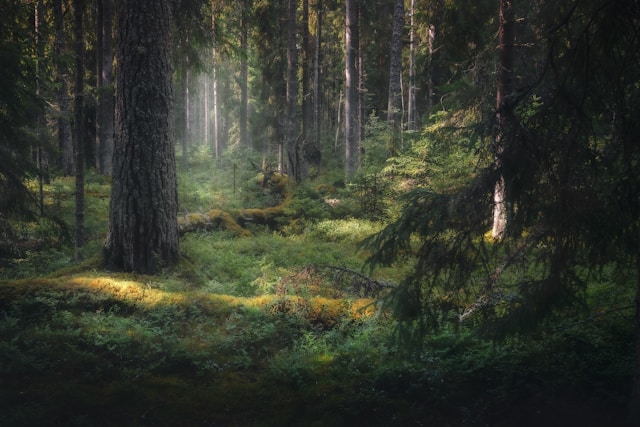In our hyper-connected, fast-paced modern lives, silence is becoming a rare commodity. The incessant hum of technology, the blare of traffic, and the constant buzz of notifications rarely leave space for true mental clarity or emotional stillness. Many of us are unknowingly drowning in a sea of sensory overload, leading to increased levels of anxiety, burnout, and disconnection from ourselves. In this context, silence is not just golden—it’s a sanctuary.
But there’s a place where the quiet is not just a pause between sounds but a symphony of subtle harmonies. Deep within wild landscapes, where human intrusion fades into the background, silence takes on a life of its own. Here, we can reconnect with the rhythms of the Earth, rediscover the lost art of presence, and experience the deep healing that only nature can provide.
One of the most profound ways to immerse in this healing silence is through the ancient Japanese practice of Shinrin-yoku, commonly known as forest bathing. Unlike hiking or outdoor workouts, forest bathing is not about achieving a goal but about simply being—walking slowly, observing quietly, breathing deeply, and letting the forest wash over you. This blog post explores the transformative power of silence in wild landscapes through the lens of forest bathing and how it can lead us to peace, mindfulness, and emotional renewal.
What Is Forest Bathing? The Art of Nature Immersion
Forest bathing, or Shinrin-yoku, originated in Japan in the 1980s as a response to the high-stress lifestyle of urban society. Recognizing the mental and physical toll of life in concrete jungles, Japanese health professionals began encouraging people to spend more time in forests for the purpose of enhancing well-being. But forest bathing is not simply walking through the woods—it’s a sensory experience designed to slow you down and tune you in.
At its core, forest bathing involves immersing yourself in a natural environment without distractions. There are no step counters, no fitness goals, and no phone calls. Instead, you walk slowly, perhaps even sit or lie down, letting your senses open to the scent of pine, the rustle of leaves, and the softness of moss beneath your feet. This gentle approach invites us to engage in present-moment awareness, which has been shown to reduce stress, lower blood pressure, and boost mood.
Unlike traditional exercise or even meditation, forest bathing provides a unique mix of mental rest and sensory engagement. You’re not striving to empty your mind but to fill it—with the rustling of branches, the chirping of birds, and the sight of dappled light filtering through the canopy. Over time, this act of presence can become profoundly healing, fostering a deep sense of calm, balance, and connection to something greater than ourselves.
The Healing Science Behind Forest Bathing
You may wonder, is there really science behind forest bathing? The answer is a resounding yes. Over the past few decades, a growing body of research has confirmed what many cultures have known for centuries—time spent in wild, natural settings has a measurable, positive impact on human health.
Studies from Japanese, Korean, and European researchers have demonstrated that forest bathing can reduce cortisol levels (a key stress hormone), improve immune function by increasing natural killer cells, and even enhance focus and creativity. One landmark study found that individuals who spent time in forests had lower heart rates and blood pressure compared to those in urban settings.
But why is this the case? Trees emit a natural substance called phytoncides, which have antimicrobial properties and are believed to positively affect human immune systems. Additionally, the forest environment stimulates the parasympathetic nervous system—the part responsible for “rest and digest”—which helps counteract our typically overactive stress response.
In essence, forest bathing aligns with the body’s natural rhythms. It calms the mind, strengthens the body, and enhances the spirit—all through the act of being, rather than doing. It’s no wonder more therapists and wellness practitioners are now recommending forest bathing as a complement to traditional treatments for anxiety, depression, and trauma.
The Symphony of Silence: Listening With All Senses
When most people think of silence, they imagine the absence of sound. But true silence in wild landscapes is anything but empty. It’s filled with the rustling of leaves in a breeze, the distant call of a bird, the crackle of twigs underfoot, and the whisper of your own breath. In nature, silence is not void—it is texture. It is the music of the Earth.
Forest bathing invites us to enter this symphony of silence with reverence and attention. Instead of pushing forward with a goal in mind, we stop and listen—not just with our ears, but with our whole being. This kind of deep listening softens our internal chatter and heightens our awareness. Over time, we begin to hear things we’ve long ignored: the subtle buzz of an insect, the rhythm of our own heartbeat, the interplay of wind and leaves.
This sensory reawakening is deeply therapeutic. Modern life encourages multitasking and overstimulation, but forest bathing teaches us to slow down and savor. Each sound becomes an invitation to return to the present moment. Each pause is a chance to notice how alive and interconnected the world really is. In this stillness, we find clarity. In this quiet, we rediscover ourselves.
Wild Landscapes as Sacred Spaces
There is something sacred about untouched wild spaces. They evoke awe, humility, and a deep sense of belonging. From ancient mountains to dense rainforests, these landscapes have inspired spiritual reflection for millennia. Indigenous cultures have long known what science is just beginning to confirm—that the land is not just scenery but sanctuary.
Forest bathing in these spaces becomes more than a practice—it becomes a ritual. The vastness of the wild mirrors the depth of the soul. As you walk through ancient groves or sit beside a flowing stream, you begin to feel part of something timeless and wise. This feeling of connection can be profound, especially for those who feel alienated in modern society.
Many forest bathers report moments of deep insight while immersed in wild nature. The stillness allows space for unresolved emotions to surface and be processed. Old grief, anxiety, or confusion may be gently held by the forest’s presence, offering not just relief but renewal. In this sense, wild landscapes are not only scenic—they are sacred therapists.
How to Practice Forest Bathing: A Beginner’s Guide

You don’t need special equipment or experience to begin forest bathing. All you need is a quiet natural setting and a willingness to slow down. The most important part of the practice is intention—choosing to be fully present in your environment, without distraction or urgency.
Step 1: Choose Your Spot Wisely
Look for a forest, park, nature reserve, or even a quiet trail. While ancient forests have a special potency, any place with greenery and minimal noise can work. The key is to find a space where you feel safe and relatively undisturbed.
Step 2: Leave Devices Behind
To truly connect with nature, leave your phone on silent or turn it off completely. Avoid taking photos or checking messages. Your goal is presence, not productivity.
Step 3: Move Slowly and Quietly
Unlike hiking or running, forest bathing requires a slower pace. Wander aimlessly. Sit when you feel like it. Lie on a patch of moss if it calls to you. Follow your curiosity rather than a trail marker.
Step 4: Engage All Five Senses
Smell the trees. Touch the bark. Listen to birdsong. Watch how the light shifts. Taste the freshness in the air. The more senses you involve, the deeper your experience will be.
Step 5: Let Go of Goals
Forest bathing isn’t about burning calories or reaching a viewpoint. Let go of time. Let go of judgment. Let go of the need to be anywhere but here.
Mental Health Benefits of Forest Bathing
The psychological benefits of forest bathing are vast and well-documented. At a time when mental health issues like anxiety and depression are on the rise, this practice offers a drug-free, accessible path to emotional balance. Simply spending time among trees can elevate mood, increase focus, and promote emotional resilience.
One reason forest bathing is so effective is that it gives the mind permission to rest. In natural surroundings, our brains shift into a more relaxed mode known as “soft fascination.” This state allows for introspection and creativity, unlike the hyper-alert state we often inhabit in our digital lives.
Moreover, forest bathing has been linked to decreased rumination—those repetitive, negative thought cycles that can fuel depression. As you become more attuned to the forest’s quiet rhythms, your inner critic softens. You begin to see your thoughts as clouds drifting across the sky rather than absolute truths.
Forest Bathing and Emotional Healing
Beyond stress relief, forest bathing can be a powerful tool for emotional healing. Trauma often disconnects us from our bodies and the present moment. Nature gently invites us back. The solidity of a tree, the coolness of a stream, the scent of pine—all of these sensory experiences anchor us in the now.
For individuals processing grief, burnout, or trauma, forest bathing can be especially soothing. There is no pressure to perform, no judgment, and no need to explain. Nature simply holds you as you are. In this unconditional acceptance, many find the space to begin healing.
Some therapists even incorporate forest bathing into trauma recovery programs. Known as ecotherapy, this approach blends psychological guidance with time spent in nature. By combining the safety of therapeutic support with the nurturing presence of wild spaces, deep and lasting transformation becomes possible.

